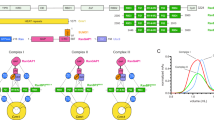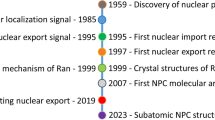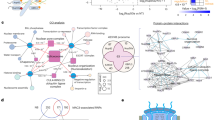Abstract
The link between nucleocytoplasmic transport and apoptosis remains controversial. Nucleocytoplasmic exchange of molecules seems indeed essential for the initiation and execution of the apoptotic programme; but inhibition of nuclear transport factors may also represent a powerful apoptotic trigger. The GTPase Ran (together with its partners), first discovered to be essential in nucleocytoplasmic transport, has multiple key functions in cell biology, and particularly in spindle assembly, kinetochore function and nuclear envelope assembly. Among the Ran partners studied, NTF2 appears to be solely involved in nucleocytoplasmic transport. Here, we localised Ran and several of its partners, RanBP1, CAS and NTF2, at the nuclear membrane in the trypanosomatid Leishmania major. Remarkably, these proteins fused to GFP decorated a perinuclear ‘collar’ of about 15 dots, colocalising at nuclear pore complexes with the homologue of nucleoporin Sec13. In the other trypanosomatid Trypanosoma brucei, RNAi knockdown of the expression of the corresponding genes resulted in an apoptosis-like phenomenon. These phenotypes show that Ran and its partners have a key function in trypanosomatids like they have in mammals. Our data, notably those about TbNTF2 RNAi, support the idea that active nucleocytoplasmic transport is not essential for the initiation and execution of apoptosis, and, rather, the impairment of this transport constitutes an intrinsic signal for triggering PCD.
Similar content being viewed by others
Log in or create a free account to read this content
Gain free access to this article, as well as selected content from this journal and more on nature.com
or
Abbreviations
- CAS:
-
cellular apoptosis susceptibility protein
- DAPI:
-
4,6-diamidino-2-phenylindole
- FISH:
-
fluorescent in situ hybridisation
- GFP:
-
green fluorescent protein
- NES:
-
nuclear exclusion signal
- NLS:
-
nuclear localisation signal
- NPC:
-
nuclear pore complex
- NTF2:
-
nuclear transport factor 2
- PCD:
-
programmed cell death
- RanBP:
-
Ran-binding protein
- RanGAP:
-
Ran GTPase-activating protein
- RanGEF:
-
Ran guanine exchange factor
- RCC1:
-
regulator of chromosome condensation 1
- RNAi:
-
RNA interference
- TUNEL:
-
terminal uridine deoxynucleotidyl transferase dUTP nick-end labelling
References
Ferrando-May E, Cordes V, Biller-Ckovric I, Mirkovic J, Gorlich D, Nicotera P . Caspases mediate nucleoporin cleavage, but not early redistribution of nuclear transport factors and modulation of nuclear permeability in apoptosis. Cell Death Differ 2001; 8: 495–505.
Yasuhara N, Eguchi Y, Tachibana T, Imamoto N, Yoneda Y, Tsujimoto Y . Essential role of active nuclear transport in apoptosis. Genes Cells 1997; 2: 55–64.
Shi WY, Skeath JB . The Drosophila RCC1 homolog, Bj1, regulates nucleocytoplasmic transport and neural differentiation during Drosophila development. Dev Biol 2004; 270: 106–121.
King FW, Shtivelman E . Inhibition of nuclear import by the proapoptotic protein CC3. Mol Cell Biol 2004; 24: 7091–7101.
Whitman S, Wang X, Shalaby R, Shtivelman E . Alternatively spliced products CC3 and TC3 have opposing effects on apoptosis. Mol Cell Biol 2000; 20: 583–593.
Quensel C, Friedrich B, Sommer T, Hartmann E, Kohler M . In vivo analysis of importin alpha proteins reveals cellular proliferation inhibition and substrate specificity. Mol Cell Biol 2004; 24: 10246–10255.
Kodiha M, Chu A, Matusiewicz N, Stochaj U . Multiple mechanisms promote the inhibition of classical nuclear import upon exposure to severe oxidative stress. Cell Death Differ 2004; 11: 862–874.
Miyamoto Y, Saiwaki T, Yamashita J, Yasuda Y, Kotera I, Shibata S et al. Cellular stresses induce the nuclear accumulation of importin alpha and cause a conventional nuclear import block. J Cell Biol 2004; 165: 617–623.
Kelley JB, Paschal BM . Hyperosmotic stress signaling to the nucleus disrupts the Ran gradient and the production of RanGTP. Mol Biol Cell 2007; 18: 4365–4376.
Joseph J . Ran at a glance. J Cell Sci 2006; 119: 3481–3484.
Field MC, Field H, Boothroyd JC . A homologue of the nuclear GTPase ran/TC4 from Trypanosoma brucei. Mol Biochem Parasitol 1995; 69: 131–134.
Vaux DL, Haecker G, Strasser A . An evolutionary perspective on apoptosis. Cell 1994; 76: 777–779.
Duszenko M, Figarella K, Macleod ET, Welburn SC . Death of a trypanosome: a selfish altruism. Trends Parasitol 2006; 22: 536–542.
Gonzalez IJ, Desponds C, Schaff C, Mottram JC, Fasel N . Leishmania major metacaspase can replace yeast metacaspase in programmed cell death and has arginine-specific cysteine peptidase activity. Int J Parasitol 2007; 37: 161–172.
Helms MJ, Ambit A, Appleton P, Tetley L, Coombs GH, Mottram JC . Bloodstream form Trypanosoma brucei depend upon multiple metacaspases associated with RAB11-positive endosomes. J Cell Sci 2006; 119: 1105–1117.
Kosec G, Alvarez VE, Aguero F, Sanchez D, Dolinar M, Turk B et al. Metacaspases of Trypanosoma cruzi: possible candidates for programmed cell death mediators. Mol Biochem Parasitol 2006; 145: 18–28.
Lee N, Gannavaram S, Selvapandiyan A, Debrabant A . Characterization of metacaspases with trypsin-like activity and their putative role in programmed cell death in the protozoan parasite Leishmania. Eukaryot Cell 2007; 6: 1745–1757.
Welburn SC, Murphy NB . Prohibitin and RACK homologues are up-regulated in trypanosomes induced to undergo apoptosis and in naturally occurring terminally differentiated forms. Cell Death Differ 1998; 5: 615–622.
Siniossoglou S, Wimmer C, Rieger M, Doye V, Tekotte H, Weise C et al. A novel complex of nucleoporins, which includes Sec13p and a Sec13p homolog, is essential for normal nuclear pores. Cell 1996; 84: 265–275.
Enninga J, Levay A, Fontoura BM . Sec13 shuttles between the nucleus and the cytoplasm and stably interacts with Nup96 at the nuclear pore complex. Mol Cell Biol 2003; 23: 7271–7284.
Scherf A, Figueiredo LM, Freitas-Junior LH . Plasmodium telomeres: a pathogen's perspective. Curr Opin Microbiol 2001; 4: 409–414.
Krysko DV, Vanden Berghe T, D’Herde K, Vandenabeele P . Apoptosis and necrosis: detection, discrimination and phagocytosis. Methods 2008; 44: 205–221.
Ribbeck K, Lipowsky G, Kent HM, Stewart M, Gorlich D . NTF2 mediates nuclear import of Ran. EMBO J 1998; 17: 6587–6598.
Smith A, Brownawell A, Macara IG . Nuclear import of Ran is mediated by the transport factor NTF2. Curr Biol 1998; 8: 1403–1406.
Fahrenkrog B . The nuclear pore complex, nuclear transport, and apoptosis. Can J Physiol Pharmacol 2006; 84: 279–286.
Gil A, Andres-Pons A, Fernandez E, Valiente M, Torres J, Cervera J et al. Nuclear localization of PTEN by a Ran-dependent mechanism enhances apoptosis: Involvement of an N-terminal nuclear localization domain and multiple nuclear exclusion motifs. Mol Biol Cell 2006; 17: 4002–4013.
Uren AG, O’Rourke K, Aravind LA, Pisabarro MT, Seshagiri S, Koonin EV et al. Identification of paracaspases and metacaspases: two ancient families of caspase-like proteins, one of which plays a key role in MALT lymphoma. Mol Cell 2000; 6: 961–967.
Ambit A, Fasel N, Coombs GH, Mottram JC . An essential role for the Leishmania major metacaspase in cell cycle progression. Cell Death Differ 2008; 15: 113–122.
Das M, Mukherjee SB, Shaha C . Hydrogen peroxide induces apoptosis-like death in Leishmania donovani promastigotes. J Cell Sci 2001; 114: 2461–2469.
Lee N, Bertholet S, Debrabant A, Muller J, Duncan R, Nakhasi HL . Programmed cell death in the unicellular protozoan parasite Leishmania. Cell Death Differ 2002; 9: 53–64.
Sen N, Das BB, Ganguly A, Mukherjee T, Bandyopadhyay S, Majumder HK . Camptothecin-induced imbalance in intracellular cation homeostasis regulates programmed cell death in unicellular hemoflagellate Leishmania donovani. J Biol Chem 2004; 279: 52366–52375.
Sen N, Das BB, Ganguly A, Mukherjee T, Tripathi G, Bandyopadhyay S et al. Camptothecin induced mitochondrial dysfunction leading to programmed cell death in unicellular hemoflagellate Leishmania donovani. Cell Death Differ 2004; 11: 924–936.
Singh G, Jayanarayan KG, Dey CS . Novobiocin induces apoptosis-like cell death in topoisomerase II over-expressing arsenite resistant Leishmania donovani. Mol Biochem Parasitol 2005; 141: 57–69.
Casolari JM, Brown CR, Komili S, West J, Hieronymus H, Silver PA . Genome-wide localization of the nuclear transport machinery couples transcriptional status and nuclear organization. Cell 2004; 117: 427–439.
Drummond SP, Rutherford SA, Sanderson HS, Allen TD . High resolution analysis of mammalian nuclear structure throughout the cell cycle: implications for nuclear pore complex assembly during interphase and mitosis. Can J Physiol Pharmacol 2006; 84: 423–430.
Maeshima K, Yahata K, Sasaki Y, Nakatomi R, Tachibana T, Hashikawa T et al. Cell-cycle-dependent dynamics of nuclear pores: pore-free islands and lamins. J Cell Sci 2006; 119: 4442–4451.
Rout MP, Field MC . Isolation and characterization of subnuclear compartments from Trypanosoma brucei. Identification of a major repetitive nuclear lamina component. J Biol Chem 2001; 276: 38261–38271.
Dubessay P, Blaineau C, Bastien P, Pages M . Chromosome fragmentation in leishmania. Methods Mol Biol 2004; 270: 353–378.
Dubessay P, Blaineau C, Bastien P, Tasse L, Van Dijk J, Crobu L et al. Cell cycle-dependent expression regulation by the proteasome pathway and characterization of the nuclear targeting signal of a Leishmania major Kin-13 kinesin. Mol Microbiol 2006; 59: 1162–1174.
Dubessay P, Ravel C, Bastien P, Stuart K, Dedet JP, Blaineau C et al. Mitotic stability of a coding DNA sequence-free version of Leishmania major chromosome 1 generated by targeted chromosome fragmentation. Gene 2002; 289: 151–159.
Blaineau C, Tessier M, Dubessay P, Tasse L, Crobu L, Pages M et al. A novel microtubule-depolymerizing kinesin involved in length control of a eukaryotic flagellum. Curr Biol 2007; 17: 778–782.
Acknowledgements
We thank Pierre Travo (Platform RIO Imaging, Montpellier) for expert advice and assistance, as well as Professor Jacques Clot for allowing access to FACS facilities at the Laboratoire d’Immunologie (CHU of Montpellier, France) and François Renaud (UMR2724 CNRS-University Montpellier 1-IRD) for support and encouragement. We also thank Yvon Sterkers notably for the western blots and Laurence Berry-Sterkers for help in microscopy. MC was a recipient of a grant from the Ministère de l’Enseignement Supérieur et de la Recherche.
Author information
Authors and Affiliations
Corresponding author
Additional information
Edited by JM Hardwick
Supplementary Information accompanies the paper on Cell Death and Differentiation website (http://www.nature.com/cdd)
Supplementary information
Rights and permissions
About this article
Cite this article
Casanova, M., Portalès, P., Blaineau, C. et al. Inhibition of active nuclear transport is an intrinsic trigger of programmed cell death in trypanosomatids. Cell Death Differ 15, 1910–1920 (2008). https://doi.org/10.1038/cdd.2008.132
Received:
Revised:
Accepted:
Published:
Issue date:
DOI: https://doi.org/10.1038/cdd.2008.132
Keywords
This article is cited by
-
RNA interference screen reveals a high proportion of mitochondrial proteins essential for correct cell cycle progress in Trypanosoma brucei
BMC Genomics (2015)
-
Comparative genomics of proteins involved in RNA nucleocytoplasmic export
BMC Evolutionary Biology (2011)
-
The trypanosome flagellar pocket
Nature Reviews Microbiology (2009)



